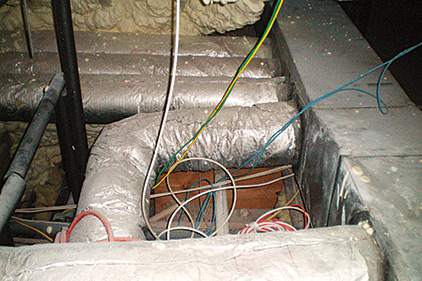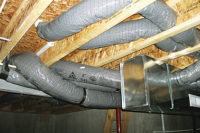
|
| Just because ducts are designed a certain way doesn’t mean they will function as intended. |
Quick duct design rules have been around for a long time and aren’t going anywhere in the near future. Multiple aspects of performance involving HVAC system components are being assumed with these rules. The effects these rules have on proper air delivery are often misunderstood.
The 0.10 friction rate is the most commonly used quick duct design friction rate for sizing ducts. The reason it is so widely used is that many slide duct calculators have a recommended residential setting on them of 0.10 inch of water column (wc). Just a word of advice, ignore this setting. If it is on the duct calculator you currently use, mark through it with a pen.
What many fail to consider is the recommended residential setting on a slide duct calculator is for 100 equivalent feet of duct. Equivalent length takes into consideration the amount of straight duct that a duct fitting is equivalent to. An example of this I’ve used before is a broad way 90-degree elbow with a square throat, round heel, and no turning vanes. This single duct fitting can easily use up 100 equivalent feet of duct by itself. That leaves you no room for the rest of the duct system. Let’s take a look at three other variables being assumed when using this duct design method.
Fan Capacity
The No. 1 item assumed when using a default duct design friction rate is that the fan is strong enough to move the required amount of airflow through the duct system. This assumption has prematurely ended the useful lives of many HVAC systems.
The majority of residential fans are rated to operate at a maximum of 0.50 inch of wc. The typical piece of equipment won’t be able to move the needed fan airflow when static pressure is over this nameplate rating. In order to verify this, you’ll need to look at the fan performance tables for the equipment you are selecting.
There are many fans out there that simply cannot move the required airflow — even if they are below the 0.50 rating. The only way you’ll find them is to do the research. With these weaker fans, in many cases, they can barely handle the addition of a coil and filter. Add an undersized duct system to this combination and you have a doomed HVAC system.
From the field data that we collect at the National Comfort Institute (NCI), we’ve found the average residential fan is operating at a total external static pressure of 0.82 inch of wc and delivering less than 300 cfm per ton in cooling mode. Guess what type of duct design method is typically being utilized the majority of the time when readings like this are uncovered?
Adequate Coil Pressure Drop
Higher-efficiency indoor coils are built with more fins per inch across the surface of the coil. Newer coils have more fins per inch than ever before with slabs that are thicker than previous coil models. This practice has resulted in coils that are so restrictive to airflow that the actual total eternal static pressure of the system is often 200 percent of the equipment’s listed rating.
With this happening, equipment airflow could be less than half of what it is assumed to be delivering due to the increased resistance of the coil. As HVAC system airflow is measured in the field, it’s common to find actual airflow delivery half of what the fan is rated to deliver.
Be sure to refer to the manufacturer’s coil pressure drop data before you randomly choose a friction rate with which to size your ducts. By using the coil’s wet/dry condition and the desired fan airflow, you can determine if the pressure drop of the coil will be within an acceptable range.
Proper Filter Sizing
Most filters are either too small or the filter media being used is too restrictive. This isn’t taken into account with quick duct design methods. You can keep yourself safe when it comes to filter sizing if you keep the filter’s face velocity below manufacturer’s recommendations. This method ensures the filter will be adequately sized and won’t restrict airflow.
Ideally, the filter pressure drop reading of the air filter should not exceed 20 percent of the rated maximum static pressure of the fan. For a fan rated at 0.50 inch of wc, the filter pressure drop should not exceed 0.10 inch of water column. If the pressure drop exceeds the 20 percent, you may need to make some changes in order for it to work properly. That is simply too much resistance for the majority of fans out there.
Pay Attention to Specifications
Before you randomly choose a duct design friction rate, take a look at the manufacturer’s specifications for the equipment and components you will be using. When you look at these specifications, pay special attention to the coil pressure drop rating and the capacity of the fan. Filter pressure drops are a little harder to obtain. If you can find them, they are just as valuable.
When looking at the manufacturer’s coil data, consider these questions:
• What is the pressure drop over the coil at the required airflow you need?
• How much of the fan’s capacity is this coil going to use up?
• Is there a better coil selection that may have a lower pressure drop?
When looking at the manufacturer’s fan performance tables, similar questions should be asked of the fan you are going to be using.
• What is the capacity of the fan at various total external static pressures?
• Is the fan strong enough to move the required volume of air with the coil and filter you have matched up to it?
• Is there a better choice that will provide me with more airflow if I need it?
By considering these variables, you can save yourself a lot of trouble by heading off problems before they ever occur. Taking a few minutes to investigate your component selection on the airside can help point out if that default duct design has the potential to work or if it is doomed from the start.
Publication date: 12/8/2014
Want more HVAC industry news and information? Join The NEWS on Facebook, Twitter, and LinkedIn today!





